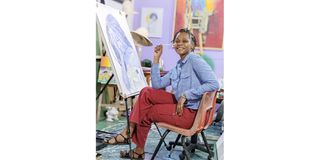Meet Anna: A rising creative ballpoint pen artist

What you need to know:
- Self-taught artist Anna Nkyalu has mastered the skill of creative expression. Using her talent as a ballpoint pen artist
Most Tanzanian societies do not appreciate art for what it truly is: a creative and relatable way of expression. For Anna Nkyalu, a ballpoint pen artist, it is a medium through which she narrates issues that concern women.
She is a self-taught creative who began drawing at an early age, seeking inspiration from her architect father.
Anna describes art as a miracle whose ending is an evolution of the lines drawn to create something.
“I am often amazed by my own art to the extent that I ask myself, “Did I do this?” This is because the whole creative process is magically beautiful. It often starts as a number of lines that end up creating something whole,” she says
Her passion saw Anna draw at every chance that she got; she would draw between classes and at home. Years later, she chose to pursue education at the University of Dar es Salaam because she did not perceive art as a supportive career.
While in university, Anna grew a habit of sharing her works on social media, and one day, one of her friends who was based in the United States of America asked her to draw her portrait. Little did she know that this act would change her point of view on art in its entirety.
“I smiled at the request and drew him with no expectations. When I shared it after completion, he sent me sh100,000 and this was like a point of realization for me that I could earn a living through art. I committed myself to lessons on how to develop my skills and the ways I could earn an income through my artwork,” she says.
Afterward, Anna began drawing with pencils after she connected with other pencil artists in the country through WhatsApp.
“There were delays in ordering pencils from urban areas to a village in Moshi, where I was living at the time. Also, over time, I realized that I did not enjoy doing pencil drawings as much as I did with a pen. An urge to make consistent good sales with my artwork came up after I discerned that I could not rely on commissions to earn money because of the inconsistency. This made me start thinking about painting, something I did not know at the time,” she recalls.
Anna approached a businessman based in Zanzibar who owned an art shop, and he connected her to two painting teachers, namely Aoso and Bampango. When she mastered painting, Anna would draw, sell them to him, and then he would increase the price before selling them to tourists.
“One morning during my painting class, Aoso asked me, “Do you want to become an artist or a businesswoman?” This was because he believed that I could make money with just a ballpoint pen, something I had not thought of. I began doing both kinds of art, as Mr Aoso advised that I would one day exhibit artworks made of a ballpoint pen. Around the same time, the coronavirus pandemic hit the world, and there were no more sales of the paintings because no tourists were visiting Zanzibar. I had to take a step back and retreat back home,” she recalls.
Anna provides further details. “I felt like my life had come to an end. I was not making any money and in the village, people did not truly value my work. Not wanting to be a burden, I picked up teaching again as a volunteer in science at a certain school in Mufindi. The whole time, my heart and thoughts were elsewhere.”
After a year and a few months, one of the teachers at the school Anna was volunteering at connected her to Mr Yaki, who supported artists, and he persuaded her to give art another chance. This made her travel back to Dar es Salaam.
“The beginning was really tough. I did not know any artists whose successful journeys would have shed light and given me hope on the path I had just taken,” she says.
Anna explains that most of her drawings are portraits of women and girls because she can effortlessly connect to them and express the message she desires to express through the women’s artworks.
“Another reason is that women have beautiful features that make the drawing process even more exciting,” she says.
Anna considers herself a social activist who seeks inspiration from her society.
“I am still finding my voice. I like to draw based on other people’s experiences and gestures,” she details.
As of recently, Anna’s artworks have been showcased in Italy and Germany, while some of them are currently getting exhibited at Rangi Gallery, which is situated in Dar es Salaam.
“I am also teaching young people how to make art at places such as Up Studio Africa, something I did not get at their ages. I feel like I have an obligation to do that and make an impact through my own experience. Their narrations down the line have to differ from my experience. It is important that they are taught art from an early age so that they explore it and do not waste their time doing things that do not make them purposeful,” she explains.
Anna advises that it is time Tanzania enhanced accessibility to art and artists in a manner that will increase the value of this creative profession.
“For art to get the value it deserves, it has to be talked about and displayed on people’s houses. Artists have to share their journeys and earn spotlights that would pose them as inspirations,” she says.





